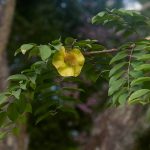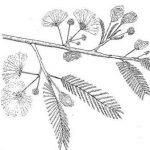TREE LIFE
July 1982
MASHONALAND CALENDAR
Saturday July 3rd : 1030 hours. Botanic Garden Walk. Meet in the Car Park.
Sunday July 18th : A visit to Stanley Farm, Chegutu, (Hartley) where the Watkins family have lived since the turn of the century. Mopane, Capparis tomentosa, Balanites aegyptiaca, Berchemia discolor are some of the more unusual gems we should see there. Bus hired. Leaves Monomatapa Car Park at 0830, Fare $8.
1983 January and February. I believe that these outings should be to a place where there is some form of shelter in case it rains in which event it would be very unfortunate for us to travel a long distance with the attendant cost only to sit in a barn or on a verandah for the day and so I would appreciate suggestions from members of ideal places near Harare with a suitable place of shelter. For that matter any suggestions of good venues would be most welcome.
Learner Group : A meeting of this group will be held during July. I have put my name down. If anyone else would like to join us please contact Mrs. Gill Masterson on 303435 between 0600 and 0630 hours or in the evenings.
BOTANIC GARDEN WALK 6TH JUNE 1982
We once again had the pleasure of the leadership of Gerald Pope for our walk which was held for the first time this winter on a Saturday. Because we were not restricted by the falling of dusk we walked and talked for longer than usual. I hope the Pope family have forgiven us for taking up so much of Gerald’s time as one of them was celebrating his 7th birthday on that day. I trust the party was a success and we offer our best wishes for many happy returns.
We first had a look at Combretum molle, velvet leaved Combretum, with a view to comparing it with C. psidioides, peeling-twig Combretum (our first record for the Gadzema area, Combretum) which has branchlets which peel much more than those of C. molle. In fact they sometimes resemble those of Terminalia sericea. It’s leaf veins and midribs are very extruded, or sticking-out, on the under surface and are intruded (valleys) on the upper surface. C. molle has leaves with an almost flat upper surface although the veins are prominent on the under surface and they do not turn such magnificent autumn colours as C. psidioides. The fruit also differ: those of C. molle are rounder and those of C. psidioides more elliptic.
We then wandered up the new stream, simply for the pleasure of doing so, and as we went into the forest there was a patch of Inyanga Canary creeper Senecio tamoides forming a ground cover on the left of the path and climbing up a huge tree. On the right was an Antidesma vogelianum, Forest Tassel berry, in fruit, its maroon berries in long pendulous spikes rather like tassels. The atmosphere of an Inyanga stream is most realistic; it even sounds right and all that is missing are the trout. We passed some massive Ensete ventricosum, wild Bananas, and then right at the top were some Wild Strelitzia, Strelitzia nicolai. Although so similar in appearance these are members of different families. Ensete belongs to the banana family MUSACEAE as do the cultivated ones, Musa cavendishii with its various cultivars and Musa paradisiaca, the Lady’s Finger or plantain. Strelitzias are members of the family STRELITZIACEAE. The Crane flower or Strelitzia of our gardens is Strelitzia reginae, and comes from the Eastern Cape where it is indigenous. Our wild Strelitzia, S. nicolai, as big as a banana plant, has flowers which are similar in shape to the Crane Flower, but are white and blue. The flowers are bird pollinated and are therefore adapted for this so, as an attractant have copious nectar which can even be seen running down the outside of the flower. The flowers are very tough and the spathe, the leaf-like sheath which encloses them, forms a platform for the bird to sit on. Nature thinks of everything. The stamens and the style lie in the blue petals which are joined to form a somewhat arrow-shape at right angles to the upstanding ones. When the bird pushes its beak into the flower to collect the nectar it opens up the blue petals and touches the anthers and style with its breast. It then flies on to the next flower. The older the flower the more copious the pollen so I presume the stigma (pollen accepting female part) matures before the anthers (pollen producing male parts) to avoid self-pollination. Next time you see a Crane flower do have a good look at it. Not only are they of beautiful shape and form but I found with this newly acquired knowledge that they are quite fascinating as well.
We then went over to look at riverine vegetation as our June outing is planned to include a riverine area. Gerald explained that of course what all riverine species have in common is that they require a lot of water. Forest species which occur in the eastern districts high rainfall area can be expected to extend on to the plateau where there is adequate water. This may be along rivers, on granite outcrops where the water has been trapped in the rocks and sometimes on anthills. He speculated as to whether the anthills had been sited over water or whether the activity of the ants caused the increase in the moisture. Perversely the first species we looked at is a true riverine species always found near water and not a forest species at all. This was the Water berry, Syzygium cordatum, with its cordate (meaning heart shaped) leaves with no petiole or leaf stalk. This tree was in flower and we were able to see how similar it is to the Blue-gum or eucalyptus tree, not surprising as they are members of the same family, MYRTACEAE. Earlier we had looked at the true forest species Syzygium gerrardii near the stream and noticed how like its leaves are to those of the Blue-gum. The other common species with which we are familiar is S. guineense, more a woodland species although found near streams and vleis, perhaps a species indicative of a high water table rather than a pure riverine or forest species.
Right at the end of the day Gerald introduced us to S. huillensis, described as a subshrub or dwarf species which occurs in and on the edge of vleis often associated with S. guineense from which it is sometimes indistinguishable apart from the fact that it produces many woody stems from a rootstock instead of a trunk. Could it take this form as a result of being frosted every year and not being able to get away to form a tree?
Another family we looked at was OLEACEAE, the olive family. First was Olea capensis, Ironwood olive, one of the many species called ironwood and perhaps one of those with most justification as it does have a very hard wood. All of us failed to recognise the next member of this family and had to be told that it was Ligustrum lucidum, the Privet. No wonder we failed to recognise it, as a member of the indigenous riverine section of the Botanic Garden. Is Tom growing it deliberately to catch us out? Next was what used to have that lovely name Linociera and is now called Chionanthus battiscombei, with its small opposite branchlets which bear the leaves with conspicuous buds in their axils. Another species that has recently suffered a name change is Olea africana, which the botanists have now decided is the same species as the cultivated Olive of the Mediterranean area, Olea europea. However, they have conceded that there is some difference and the trees which grow here are subsp. africana while the Olive tree of Europe is subsp. europea.
Related to the date palm, Phoenix dactylifera, we looked at Phoenix reclinata, starting to recline, or bend its way round the shade to the light.
There was so much that we looked at and talked about, in fact, probably enough to fill another Newsletter. Perhaps we will see some of these species at Langford Farm and I will be able to include them in my account of that trip. In the meantime it remains for me to thank Gerald for giving up his Saturday morning and for the fore-thought and preparation he had obviously made. I can assure him that it was most appreciated.
VISIT TO LANGFORD FARM 20TH JUNE 1982
On Sunday 20th June we spent an exceptionally happy day, although the story has a very sad beginning. On the previous Sunday we had been out to do a recce and found that the woodcutters had beaten us to it. This was most upsetting and disappointing for us, but Mrs. Pat Bellingham must feel devastated. No chopping has been allowed in that area in the nearly 30 years that the Bellinghams have owned Langford farm. Although the chopping by their own staff has again been stopped, word has got around and wood choppers have been crossing the river, even at night, and that area is no longer a happy place for tree lovers. So we decided to return to the spot the Society had visited previously. And here, I would like to express our thanks to Mr. Ray Graves, the Manager, who cleared a road to enable us to reach our destination in maximum comfort, arranged for a guard to patrol the area so that no last minute wood-cutting would spoil our day and organised for their police to be on duty and guide us to the correct place. And of course our very grateful thanks to Pat Bellingham, the moving spirit behind all these arrangements.
The day dawned cloudy and as to be expected there was a howling gale at the Monomatapa Car Park which had everyone scuttling into the bus. There were a few other people in shorts and our faith in the weather was justified. Although it remained overcast for most of the time we were sheltered from the wind and there were no complaints about the weather.
One of the features of the day were the colours, which were as variable as they were beautiful.
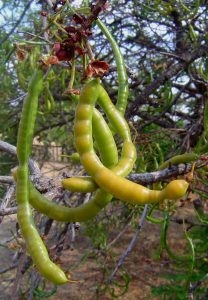
Cassia singueanai. Photo: Bart Wursten. Source: Flora of Zimbawe
There was the lovely clear yellow of the Winter Cassia, Cassia singueana, mostly occurring singly but in one spot there was a group of them all with their flowers at the same stage. On the other hand some of them had not yet lost their leaves and we were able to see the infallible tip for this tree, the glands looking just like little stalks or bee-stings along the rachis between each pair of leaflets. We also saw a Cassia abbreviata, long tail Cassia, The many Ochna schweinfurthiana were bigger than we often see and were an orangy yellow and very spectacular. Closer inspection revealed the very coarse serrations on the margins of the leaves, botanically described as “densely curved serrulate” (“serrulate” means “finely notched”). The bark is also distinctive and again I quote “dark grey and reticulately fissured”. (Reticulate comes from the Latin “reticulatus” (latticed) and means like net-work). It looked as though someone had been along with a sharp knife and made regular little cuts all the way round and up the bark. One member suggested that that was how I had spent Saturday afternoon and wanted to change the name to “meg cut-ii”. The leaves of the Peeling bark Ochna, Ochna pulchra were also turning yellow – a yellow with not quite as much red as those of O. schweinfurthiana. The margins of the leaves of O. pulchra are in the main entire although a few of them were, and again I quote “densely appressed-spinulose-serrulate”, meaning with pressed together spiny little notches, which are in effect almost impossible to see. In fact we only realised that they were there when we ran our fingers against the margins and found that when present the “spiny little notches” really are sharp. The lack of serrations on the margins of the leaf were often the only feature which told us we were looking at O. pulchra and not O. puberula which has small leaves like O. pulchra with margins like O. schweinfurthiana as although some of the Peeling-bark Ochnas had bark which peeled beautifully others were so atypical that some people felt that they had been cheated and said that they thought that they ought to go home! The Strychnos of the area was S. cocculoides, the characteristic 3-veined from the base leaves turning yellow with the fruit green speckled with white forming a striking contrast. Even those not in fruit declared their identity with their very corky bark.
Unmistakable, usually against a grey granite back ground, with its huge leaves yellow and rather wrinkled waiting to fall was Canthium lactescens. Gummy Canthium. Both the specific and the common names refer to the milk or gum which is produced when a branch is broken or the growing tip is squeezed. Apparently this is very slow growing, only one pair of leaves and an internode being added each year. The stem and branches are almost a chocolate colour which added to the colour of the day.
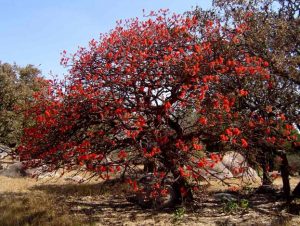
Erythrina abyssinica. Photo: Bart Wursten. Source: Flora of Zimbabwe.
The brightest red was that of the flowers of Erythrina abyssinica, all big trees and well above our heads although occasionally something, bird or monkey, had snipped off the flowers and they formed a carpet under foot. From the leaf point of view one would be hard pressed to say which of the reds was the most spectacular. Perhaps it was Ekebergia benguelensis, its leaflets red on the upper surface and very pale underneath, attached to a very red rachis, usually slightly winged in that at least one part telling us that this was definitely an Ekebergia. With their asymmetric bases and pale under surface one could be forgiven for confusing this with the Purple leaved Albizia, albizia antunesiana. However, without the give-away purple tinge, A. antunesiana is bi-pinnate and Ekebergia is once pinnate which immediately separates them (Pinnate is having leaves on either side of an axis, midrib or rachis and bi-pinnate is when the rachis has paired stems called rachilla on either side and these bear the leaflets. Another contender for pride of place with its red leaves was Combretum molle, velvet leaved Combretum, the small saplings and coppice growth being more spectacular than the big trees. As always, very variable, sometimes softly velvety and sometimes glabrous (without hairs) was Flacourtia indica with its leaves just starting to turn and rather more purple than red. It is so like Scolopia zeyheri that I wondered if the glabrous ones might be that but the fruit found were all longer than 1cm. which is too long for S. zeyheri.
We started the day by making for the beacon which stands on a granite outcrop, proud above the surrounding trees but remarkably hidden unless one is right near it and of course, as so often happens, one granite outcrop looks so like another that during the course of the day the beacon got lost several times. The short-in-distance walk to the beacon took the usual length of time with the usual discussion, discovery and disagreement. The scramble up to the beacon was not too much of a scramble and most people made it past a Cassine aethiopiea and not helped at all by the prickles of the Red-wing creeper, Pterolobium stellatum without the beauty of the fruits as compensation. From the top we looked down on a big Ziziphus mucronata, a view we do not often enjoy. Only some of the branchlets had the characteristic pairs of thorns, one hooked and the other straight and pointing in the opposite direction, which gives rise to the common name Wag-‘n-bietjie or Wait a bit. Funnily enough this lack of thorns is also as characteristic as are the 3 veins from the very asymmetric bases of the leaves and the little red-brown fruit. And then we came across our most unusual tree of the day Synadenium – Deadman’s tree, reputed to be so poisonous that the ground beneath the tree is supposed to be white with the bones of the animals which have died as a result of contact with it and even when a bird flies over the top it is supposed to fall down dead. Synadenium is a member of the family EUPHORBIACEAE and very closely related to Euphorbias themselves; the milky latex has the same poisons as that of E. ingens and E. cooperi. There is a garden Synadenium with purplish leaves and I am told it is called Bloody Mary but can find no verification of that. I have deliberately not given a specific name as to date as far as I know the experts have not yet decided which species does grow here. Other highlights were an enormous Acacia sieberiana, paperbark Acacia, a picnic spot of the young Bellingham’s. Unfortunately it was showing signs of its age and two branches had broken and fallen. Just to complete our day as we came out of the trees into the long grass of an old land we put up a duiker which bounded gracefully away.
After lunch we really had fun. We had a scavenger hunt with a botanical flavour. The only non-botanical item required was a feather and as there was plenty of evidence of the presence of guinea fowl that presented no problem. Groups of about 5 people were set the task of collecting 30 of the things we had seen during the morning. At the end of the exercise, I think that everyone realized that they really knew a bit more than they thought, that their powers of observation were better than they hoped, and that they had learnt a little, had got to know other members and, most of all, had had a lot of fun. One team did manage to collect every item and Pat Bellingham very kindly presented each member of that team with a little parcel, beautifully wrapped, containing, appropriately, a gift of eggs. She also very kindly presented the Chairman with a chicken. The leader of the team with the least points was presented with a booby prize of an animal skull, probably of a sheep , which had been found during the morning. We all went home happy with our spoils and our memories. Thank you Pat.
-Meg Coates Palgrave
MATABELELAND BRANCH CALENDAR
Sunday July 11th : Joint Tree/Bird field meeting at Tshabalala Game Sanctuary. This Game Park is the only predominantly Acacia one in the country and will therefore be an interesting ecological study. Meet at 0800 hours at Retreat. A morning outing.
August meeting Friday 6th : Film and social. 1930 hours at Milton Secondary School Pavilion entrance to grounds at Selbourne Avenue. Cake and Coffee.
September – Third Weekend : On Sunday September 19th the Mashonaland members are coming to Sable Park, Kwekwe and have invited us to join them for the day. With the prospect of good trees and good company it is a fine prospect. Please plan for this; keep the date clear.
BRANCH OUTING JUNE 1982
Zimbabwe is the host country for a gathering of Boy Scouts and Girl Guides in August, the venue being Gordon Park in Rhodes Matopos National Park. Great plans are being carried out for this “Zimfari” as it is called, and members of the Tree Society were surprised at the building which had been successfully complete, mainly by the Gordon Park Crew, in readiness for these overseas visitors. The very fine Naomi Connoly Lodge, grey among the trees, with electric light and parquet flooring is one such achievement. We went to label the trees and there was a good turnout of people; this project is to help local and visiting scouts appreciate our wonderful woody vegetation. The labels looked very fine and there is a printed sheet giving facts about the uses and other interesting information about the trees. We wish to record our appreciation of the financial help and practical encouragement of the parent club in this exercise.
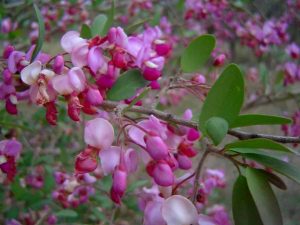
Securidaca longipendunculata. Photo: Bart Wursten. Source: Flora of Zimbabwe.
At the Scout training grounds were some very fine specimens of Burkea africana, Combretum hereroense, Pterocarpus rotundifolius, Securidaca longipedunculata, Terminalia both stenostachys and sericea. Trees sure to fire the imagination of boys are Acokanthera schimperi (var. rotundifolia) and Urera tenax – 2.5m high. Aromatic trees were Croton gratissimus, growing thickly at the foot of the Gordon Park Rock – that training area for abseiling, Heteropyxis dehniae and Ptaeroxylon obliquum. In the fruit class were Flacourtia indica, Grewia flavescens and G. monticola, Sclerocarya caffra and Ximenia caffra, a pity the visitors will not see the flowering and fruiting of some of our attractive trees, e.g. Ochna glauca and O. pulchra, etc. Uncommon things were Maerua parvifolia and Margaritaria discoidea, locally uncommon. However there are six species of Ficus, F. capensis, F. ingens, F. natalensis, F. soldanella, F. glumosa and F. tettensis; four species of Strychnos, S. matopensis, S. innocua, S. cocculoides and S. spinosa. On the dwalas were tall Kirkia acuminata and in the valleys Faurea saligna, Parinari curatellifolia (only one), Pterocarpus angolensis and so many others.
It was a sunny day and we had a braai lunch. A request was made for other areas to be done such as the area around the Lodge where the cubs will sleep, and a rock habitat; this is a must because it provides three species of Commiphora, C. marlothii, C. mollis and C. pyracanthoides also Albizia tanganyicensis, the red paper tree.
-J.W.
NOTES BY GEORGE HALL ON PROGRESS AT THE MAKABUSI WOODLANDS
1 Building and Caretaker’s cottage is about to begin
2 The main and the Blatherwick ablution blocks are rising rapidly
3 The first dam on the Chiraua River has been completed and a second has been planned. Although the first dam is no Kariba and was completed in a matter of days, nevertheless the story is interesting. Two cofferdams had to be built (remember Kariba?) to halt the still flowing stream and one of them has formed a pleasant pond and a delightful island. It is hoped that this will remain as a permanent feature.
4 A second nature trail is under construction and further ones planned.
In spite of the smallness of the project there had to be a great deal of earth moving to be done and this has left dreadful scars on the ground. Re-grassing the spillway has already been arranged by George Hall as the dam was expected to spill (albeit at a very slow rate) during the second week in June; on June the 1st it was only 300mm below spillway level.
TREES OF SOUTHERN AFRICA by Coates Palgrave
The second impression has a number of errors that could be confusing to the reader. Not scientific errors but irritating things like a name change being made in the text but not in the index or the key or a wrong page reference being given in the index. We have produced an errata sheet with which anyone can correct their copy and we will be very willingly send on to anyone who asks us to do so. Originally it was to be included in all the unsold copies of this impression but the second impression is selling out much faster than expected and so this will never be done. We are now finalising the corrections for the third impression which is expected to be available in the bookshops about Christmas 1982 and we sincerely hope that this one will be correct.
-Meg Coates Palgrave, Chairperson


